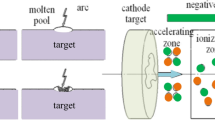Abstract
This paper proposes a model to predict the material removal mode in soda-lime glass micro-grinding. This model defines material removal process to three stages which conclude ductile type, ductile-brittle type and brittle type by the quantization of undeformed chip thickness h m . The model for computing undeformed chip thickness in micro-grinding has been built considering tool topography, grit distribution and size effect in this paper. Micro-grinding experiments with different cutting depth on soda-lime glass have been designed and conducted. From experiment results, it was found that the edge crack length tends to have a wide range with different h m . Three types of chip have been investigated in results, and coolant has been verified to be an important factor to soda-lime glass ductile-regime micro-grinding. Critical depths of soda-lime glass micro-grinding have been found to be 2 and 5 nm, grinding forces in experiment provide the proof to predictive model proposed by this paper.
Similar content being viewed by others
References
Dornfeld D, Min S, Takeuchi Y (2006) Recent advances in mechanical micromachining. Annals CIRP 55(2):745–768
Malkin S, Hwang T (1996) Grinding mechanisms for ceramics. Ann CIRP 45:569–580
Chuzhoy L, DeVor R, Kapoor S, Beaudoin A, Bammann D (2003) Machining simulation of ductile iron and its constituents. Part I: estimation of material model parameters and their validation. ASME J Manuf Sci Eng 125:181–191
BifanoT DT, Scattergood R (1991) Ductile-regime grinding, a new technology for machining brittle materials. ASME J Eng Industry 11(3):184–189
Liu K, Li X (2001) Ductile cutting of tungsten carbide. J Mater Proc Technol 113:348–354
Horvath M, Kundrak J, Mamalis A, Gyani K (2002) On the precision grinding of advanced ceramics. Int J Adv Manuf Technol 20(4):255–258
Liu K, Liang S, Liu X (2005) Nanometer-scale, ductile-mode cutting of soda-lime glass. J Manuf Process 7(2):95–101
Feng J, Chen P, Ni J (2012) Prediction of surface generation in microgrinding of ceramic materials by coupled trajectory and finite element analysis. Finite Elem Anal Des 57:67–80
Peng Y, Wu Y, Liang Z, Guo Y, Lin X (2011) An experimental study of ultrasonic vibration-assisted grinding of polysilicon using two-dimensional vertical workpiece vibration. Int J Adv Manuf Technol 54(9–12):941–947
Umbrello D (2011) Influence of material microstructure changes on surface integrity in hard machining of AISI 52100 steel. Int J Adv Manuf Technol 54(9–12):887–898
Schaller T, Bohn L, Mayer J, Schubert K (1999) Microstructure grooves with a width of less than 50 mm cut with ground hard metal micro-end mills. Precis Eng 23:229–235
Özel T, Zeren E (2007) Finite element modeling the influence of edge roundness on the stress and temperature fields induced by high-speed machining. Int J Adv Manuf Technol 35:255–267
Morgan C, Vallance R, Marsh E (2007) Specific grinding energy while microgrinding tungsten carbide with polycrystalline diamond micro tools, ICOMM-2007 2nd International Conference on Micro-Manufacturing, Sept. 10, 2007,Greenville, South Carolina, USA, No. 39
Aurich J, Engmann J, Schueler G, Haberland R (2009) Micro grinding tool for manufacture of complex structures in brittle materials. CIRP Ann Manuf Technol 58:311–314
Kim J (2005) The effects of dynamic characteristics on the surface texture in mirror grinding. Int J Adv Manuf Technol 27(3–4):274–280
Malkin S (2002) Grinding technology theory and applications of machining with abrasives. Society of Manufacturing Engineers, Dearborn, 2002.8
Zhou X, Xi F (2002) Modeling and predicting surface roughness of the grinding process. Int J Mach Tool Manuf 42:969–977
Hwang T, Evens C, Malkin S (2000) High speed grinding of silicon nitride with electroplated diamond wheels, part 1: wear and wheel life. ASME J Manuf Sci Eng 122:32–41
Chen X, Rowe W (1996) Analysis and simulation of the grinding process, part 1: generation of the grinding wheel surface. Int J Mach Tool Manuf 36(8):871–882
Blake P, Scattergood R (1990) Ductile-regime machining of germanium and silicon. J Am Ceram Soc 73(4):949–957
Author information
Authors and Affiliations
Corresponding author
Rights and permissions
About this article
Cite this article
Cheng, J., Gong, Y.D. Experimental study on ductile-regime micro-grinding character of soda-lime glass with diamond tool. Int J Adv Manuf Technol 69, 147–160 (2013). https://doi.org/10.1007/s00170-013-5000-3
Received:
Accepted:
Published:
Issue Date:
DOI: https://doi.org/10.1007/s00170-013-5000-3



